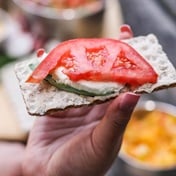- In a recently published study, researchers looked at the temperature at which foods and beverages are sold
- They found that the serving temperature systematically impacts food ordering and purchase behaviour of consumers
- These results, they say, may have policy implications and help people maintain healthy eating patterns
Previous research has shown that grocery shopping on an empty stomach is a terrible idea, as high-calorie foods can become more tempting than usual.
In another interesting new study, researchers have found that food temperature might lead you to make additional, unnecessary food purchases.
The study, published in the peer-reviewed journal Appetite, notes that a series of studies were conducted to assess whether people would purchase additional food items (such as side orders and snacks), after choosing meals served either cold or hot.
According to the findings, participants chose more additional food items when selecting items served cold rather than hot. This is because “cold consumables are expected to be less satiating [the feeling of fullness] compared to hot consumables”, the researchers wrote.
The ‘serving temperature effect’
In their study, the researchers refer to a phenomenon known as the “serving temperature effect”, which describes the tendency of individuals to buy more food and beverage items when the main item they intend to purchase is served cold rather than the same item served hot.
As a result, not only do we end up spending more money, but this additional food product purchasing could add unnecessary calories to our meals.
Past studies, limited understanding
While there is a body of studies looking at the serving temperature and how it affects the palatability of food and beverages, the authors of the new study indicate this to be limited and the results to be mixed.
Moreover, these past studies are somewhat dependent on the particular food under investigation, while the latest study builds on these findings by suggesting that irrespective of food type (such as soup, cheese, and sandwiches), expected satiety differs for a food served hot versus the same food served cold.
How the study was carried out
The study was conducted in an established restaurant that offers a variety of sandwiches (which can be ordered cold or hot), salads, beverages, and snacks (chips and cookies).
At this particular restaurant, most lunch and dinner food transactions are single-order, one-customer-per-transaction orders. The research team analysed 123 receipts from the restaurant in order to understand the customers’ purchase behaviour. All the studied transactions took place from 11:30 am to 7:30 pm over a two-week period (end of May to beginning of June).
Apart from the restaurant manager, all restaurant staff and consumers were unaware of the study taking place.
Since the researchers were interested in comparing across conditions of like-foods (cold and hot sandwiches), they studied receipts that included a sandwich. Receipts that included only snacks, beverages, or salads were therefore excluded. Calories for each food item were obtained from the restaurant’s menu.
The findings
Results revealed that customers who ordered a cold (versus hot) sandwich were nearly twice as likely to order one or more complementary items with their sandwich, such as a bag of chips, cookies, and/or a caloric beverage.
“Results of this study… [show] that those who bought a cold rather than hot sandwich purchased more (versus fewer) complementary items during a consumption episode, and spent more money at retail. This translated into additional calories purchased," the authors wrote.
In fact, they spent $0.67 more, on average, on complementary food items and seemed to engage in caloric balancing efforts by adding an average of about 65 calories to their meal, with beverages accounting for about two-thirds of that increase, they added.
Second study in a coffee shop
Although their data was limited to purchases, they therefore could not confirm that the additional items were actually consumed in a single consumption episode. However, the researchers suggest it is a reasonable assumption that a customer adding a cookie to their lunch sandwich intends to consume it, "and that results of this study point to serving temperature as a factor that may influence total calories consumed per episode”, they said.
In an effort to generalise their findings, they replicated their results in a coffee shop that focuses on non-meal foods and beverages and found the following:
“Coffee shop patrons who bought a cold rather than hot beverage were about three times as likely to purchase complementary food items, spend nearly a dollar more on such items, and add calories to their consumption episode,” they wrote.
Implications of the results
According to the researchers, these findings imply that simple and relatively painless “nudges” related to the temperatures of consumables could be utilised to help people control their caloric intake.
More importantly, they add that it may have policy implications. “Given the severe health and financial consequences of being overweight and/or obese, this research may contribute to the development of useful strategies in fighting obesity that involve incorporating a hot item into the consumption episode to reduce the intake of additional foods or beverages,” they wrote.
In terms of maintaining healthy eating patterns, they note that understanding the sensory factors that systematically lead to increased consumption and purchase (such as that of the serving temperature effect) will help contribute toward achieving the goal of a healthier consumer population.
READ | Why one-size-fits-all diets don't always work
READ | Is calorie counting the only way to achieve sustainable weight loss?
READ | The Eurocentricity of diets: How to incorporate culture into healthy eating
Image credit: Getty Images




 Publications
Publications
 Partners
Partners












